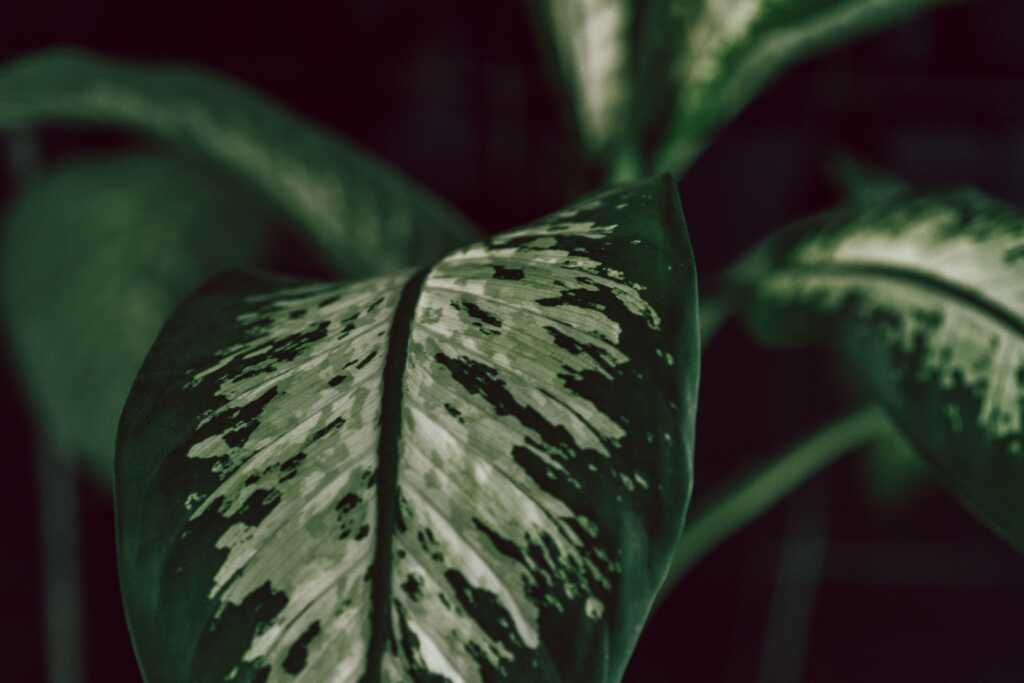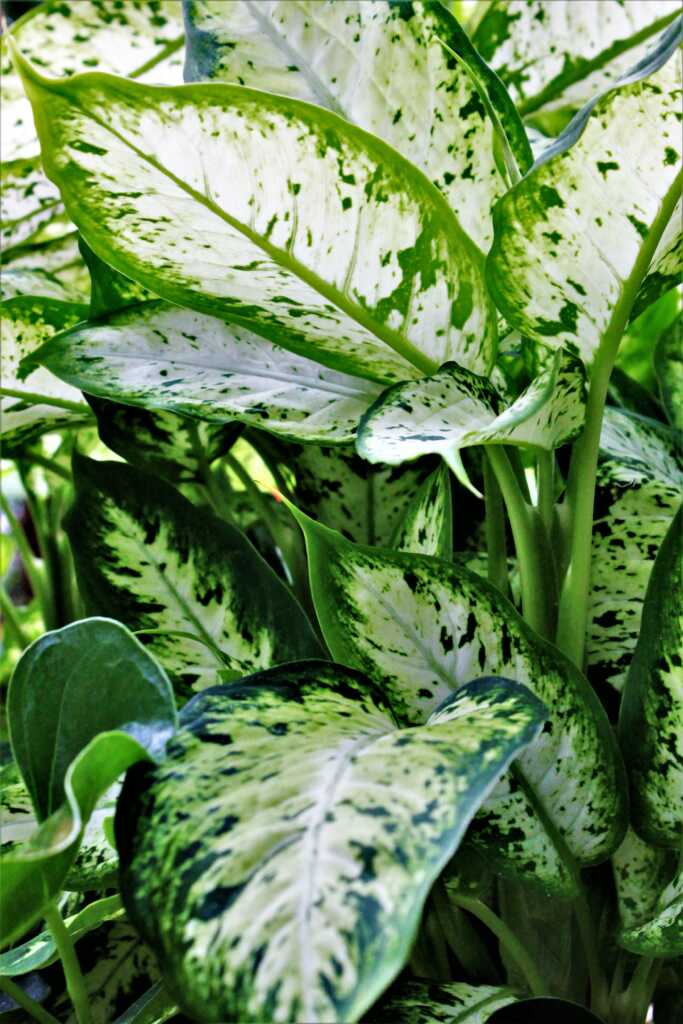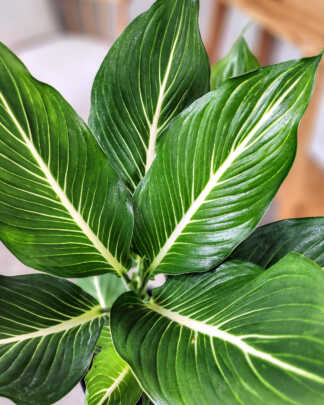Dieffenbachia, also known as the “Dumb Cane” or “Leopard Lily,” is a popular houseplant cherished for its striking, patterned foliage. Native to the tropical rainforests of Central and South America, this plant belongs to the Araceae family. It’s an excellent choice for indoor gardening due to its low maintenance and visually appealing leaves.

Dieffenbachia plants feature large, lush leaves with unique patterns. These patterns vary from plant to plant, displaying a mix of green, white, and yellow. The leaves are broad, pointed, and can grow up to 18 inches long. Dieffenbachia reaches an average height of 3-6 feet indoors, making it a perfect fit for home and office spaces. The plant is not only known for its beauty but also for its air-purifying qualities, making it a healthy addition to indoor environments. However, it’s important to note that the sap of Dieffenbachia is toxic if ingested, so caution is advised around pets and children.
Light Requirements
Dieffenbachia thrives in bright, indirect light. It can tolerate low-light conditions, but its growth will be slower, and the leaves may lose some of their vibrant variegation. Direct sunlight should be avoided as it can scorch the leaves, leading to yellowing or browning. A north-facing window or a spot that receives filtered light through sheer curtains is ideal. If your Dieffenbachia is not getting enough light, its leaves may become smaller, and the plant may become leggy as it stretches towards the light source. In such cases, consider using a grow light to supplement natural light.
Watering and Humidity
Dieffenbachia prefers consistently moist soil but is sensitive to overwatering, which can lead to root rot. Water the plant when the top inch of the soil feels dry to the touch. Reduce watering in the winter when the plant’s growth slows down. Use lukewarm water to avoid shocking the plant’s roots.
This plant enjoys a humid environment, mimicking its native tropical habitat. Indoor air, especially in homes with central heating or air conditioning, can be too dry for Dieffenbachia. To increase humidity, you can mist the plant regularly, place a humidifier nearby, or set the pot on a tray filled with pebbles and water. Make sure the bottom of the pot is not sitting in water, as this can lead to root rot.
Soil and Fertilization
Dieffenbachia prefers well-draining soil rich in organic matter. A standard potting mix with peat, perlite, and vermiculite works well. You can also add some compost or bark to enhance drainage and aeration.
Fertilize Dieffenbachia every four to six weeks during the growing season (spring and summer) with a balanced, water-soluble fertilizer. Follow the instructions on the fertilizer package for the correct dilution. Over-fertilizing can damage the plant, so it’s better to err on the side of caution. In fall and winter, when the plant’s growth slows down, reduce fertilization to once every two months or stop altogether.
Temperature
Dieffenbachia prefers warm temperatures between 65-75°F (18-24°C). It can tolerate a short period of temperatures as low as 50°F (10°C), but prolonged exposure to cold can harm the plant. Keep your Dieffenbachia away from drafts, air conditioning vents, and heat sources.
Good air circulation is also important for Dieffenbachia. Stagnant air can lead to pest infestations and fungal diseases. Ensure the plant is in a well-ventilated area, but not in the path of strong winds or drafts.
Pruning and Maintenance
Pruning helps maintain the Dieffenbachia’s shape and encourages new growth. Use clean, sharp scissors or pruning shears to remove yellow or damaged leaves at the base of the stem. You can also trim back leggy growth to encourage a fuller plant.
Wipe the leaves with a damp cloth periodically to remove dust and help the plant breathe and absorb light more efficiently. This also helps in inspecting the plant for pests such as spider mites, mealybugs, and aphids. If pests are found, treat the plant with insecticidal soap or neem oil.
Repotting and Propagation
Repot your Dieffenbachia every 2-3 years or when it becomes root-bound. Choose a pot that is one size larger than the current one and has drainage holes. Repotting is best done in the spring, which gives the plant time to acclimate and grow in the new pot.
Propagation of Dieffenbachia is relatively easy. You can propagate by stem cuttings or by dividing the plant during repotting. To propagate by stem cuttings, cut a piece of stem about 4-6 inches long, remove the lower leaves, and plant it in moist soil. Keep the soil moist until the cutting establishes roots.
Dieffenbachia is an attractive and easy-to-care-for plant that adds a tropical flair to any indoor space. By providing the right balance of light, water, humidity, and nutrients, you can enjoy the lush, vibrant foliage of this plant for many years. Remember to handle it with care due to its toxic sap and keep it out of reach of pets and children. With regular maintenance and attention to its basic needs, Dieffenbachia will be a stunning and rewarding addition to your collection of houseplants.

The History of the Dumb Cane
The genus Dieffenbachia was named in honor of Joseph Dieffenbach (1796–1863), a noted Austrian horticulturist who worked as the chief gardener at the Schönbrunn Palace, one of the most significant cultural monuments in Austria. Dieffenbach was instrumental in introducing and cultivating various exotic plant species in Europe, and his contribution to horticulture was commemorated through this naming.
Historically, Dieffenbachia holds a significant place in indigenous cultures. In its native habitat, the plant was not only admired for its beauty but also utilized for various practical purposes. The sap of Dieffenbachia contains calcium oxalate crystals, which are known for their irritant properties. Indigenous people found uses for this characteristic; for instance, the sap was sometimes used as a component in arrow poisons. The plant’s common name, “Dumb Cane,” originates from the temporary speechlessness that occurs when the sap comes into contact with the mouth, causing swelling and numbness.
Dieffenbachia’s journey from the American tropics to global popularity began primarily in the 19th and 20th centuries. European explorers and botanists, fascinated by the unique flora of the New World, brought back many plant species, including Dieffenbachia, to their native countries. Its ease of cultivation and striking appearance made it a favored ornamental plant in Victorian-era homes, where it symbolized exoticism and a connection to far-off lands.
Over the years, numerous cultivars of Dieffenbachia have been developed, each boasting different patterns and color variations on their leaves. These cultivars have further enhanced the plant’s popularity, making it a staple in homes and offices worldwide.
-
 Dieffenbachia ‘Sterling’$64.00
Dieffenbachia ‘Sterling’$64.00



